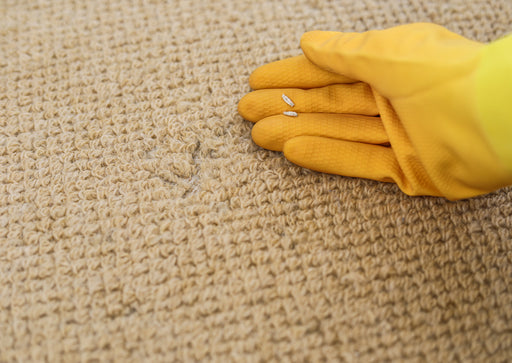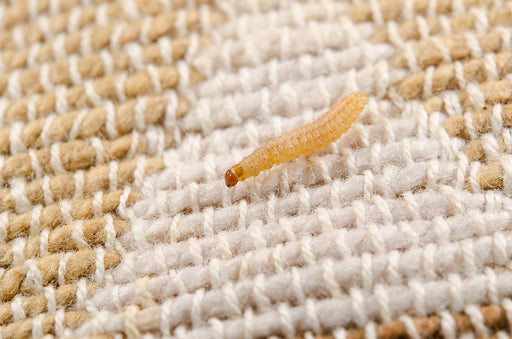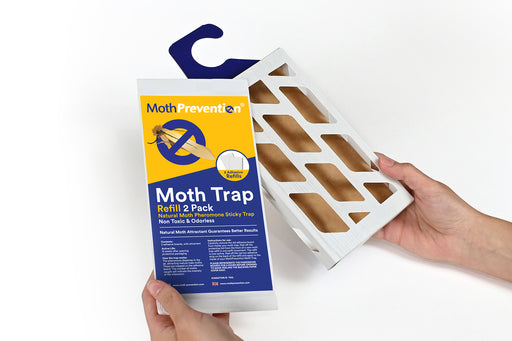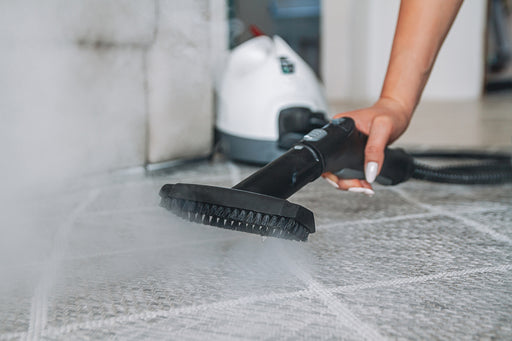What Are Carpet Worms and How to Get Rid of Them

Have you been noticing tiny white, brown, or black caterpillars near the floorboards or underneath carpeting in your house? Are there now threadbare patches of carpet or signs of rug damage near your walls or beneath your furniture? If so, “carpet worms” could be to blame. These destructive pests can be very frustrating to encounter! However, they can often be eliminated and prevented in just a few steps.
So what exactly are carpet worms, and how can you eliminate them?
Little wormy insects crawling around near the carpet are sometimes called carpet worms, carpet maggots, or carpet caterpillars. Although these little insects may resemble worms, they are usually the larvae of other invasive household pests like carpet beetles, Clothes Moths, or Carpet Moths. To eliminate these pests from your home, you will need to thoroughly clean all infested areas and take measures to prevent a re-infestation.
Using moth traps can be a proactive way to target these larvae before they cause extensive damage.
In this comprehensive guide, we will discuss how to get rid of worms in carpet spaces, beneath furniture, and in the corners and crevices of your home. We will also go over what these worms actually are, and answer your frequently asked carpet pest control questions. Don't forget to check out our range of moth traps to ensure complete protection for your home. That way, you can rid your house of these creepy crawlies and prevent further destruction from taking place!
What Are Carpet Worms: Identifying The Tiny Worms In Carpet
Carpet worms may be caused by an array of pestilent insects with larvae that feed on keratin which is a protein found in animal based fibers. Carpets, rugs, tapestries, flooring glues, or even upholstered furnishings are all at risk if they contain this protein because hungry Carpet Beetle Larvae, Carpet Moths and Clothes Moth Larvae will feast on keratin. These insect larvae may resemble small brown, black, tan, or cream-colored worms.
Where to find these worms/larvae?
Insect larvae of this kind will often congregate near baseboards, in crevices, underneath furniture, near the legs of heavy furnishings, or in other dark, warm, undisturbed places. They may also accumulate in the center of a room or under the padding of carpets. Positioning moth traps in these locations can significantly reduce the risk of infestation.
What are the signs of carpet worms?
Oftentimes, these insects leave threadbare patches in rugs and carpets. They may also be pinpointed by debris like cocoons, webbing, or tubular casings. Or, you could simply find live or dead larvae or adults flying around.

Here's a breakdown of different “carpet worms” and what these larvae and nymphs may look like.
• Clothes Moth Larvae
Clothes Moths (Tineola bisselliella) are common in Europe and North America. There are a few different types of Clothes Moths including the Case Making Clothes Moth, the Common Clothes Moth, and the Webbing Clothes Moth. As adults, these moths are a buff-beige color and measure about ½ of an inch long. Clothes Moth Larvae feed on keratin, a naturally occurring animal protein. Keratin can be found in hair, leather, wool, feathers, felt, silk, cashmere, and an array of other fibers. When carpets contain fibers like this, female Clothes Moths will lay eggs in a dark and quiet place where their larvae can consume the food source. The eggs hatch into larvae that many feel resemble small white or yellow worms.
What do Clothes Moth Larvae look like?
Webbing Clothes Moths and Case Bearing Clothes Moths sometimes lay their eggs near carpets that contain keratin fibers. The larvae of these moths measure about a quarter of an inch long and can be quite worm-like in appearance. Usually, these caterpillars will have brown or tan heads and bodies that are light yellow, white, or cream colors.
• Carpet Beetle Larvae
As the name implies, Carpet Beetles are known to infest carpets. Like Clothes Moth Larvae, these larvae feed on an array of natural keratin fibers and animal proteins. This could include felt, wool, silk, fur, feathers, animal hides, or other materials containing keratin.
Placing moth traps near carpets and upholstery is an effective way to monitor and reduce infestations.
What do Carpet Beetle Larvae look like?
The larvae of the carpet beetle may vary in appearance depending on the exact species of beetle you are dealing with. Generally, these worm-like larvae measure 4 to 5 mm long. They also have coarse hairs that cover their bodies. Generally, Carpet Beetle Larvae have oval or carrot-like shapes and can be tan or brown in color. They may also have lighter tan or white stripes. Hairs visible along the sides and back of these larvae can help you identify whether they belong to the carpet beetle.
• Carpet Moth Larvae
Worms in the carpet could also indicate a Carpet Moth infestation. Carpet Moths and Tapestry Moths (Trichophaga tapetzella) are in the family Tineidae, which can be found worldwide. Like Carpet Beetles and Clothes Moths, Carpet Moths consume animal based fibers. Their larvae can also eat heavily soiled synthetic fibers, although they primarily consume keratin materials.
Defend your carpets by using moth traps in quiet and dark corners of your home.
What do Carpet Moth Larvae look like?

Carpet Moth larvae look somewhat similar to maggots. Female Carpet Moths lay their eggs in quiet, warm, or dark spaces. The eggs hatch into white, yellow, or cream-colored larvae. The heads of these larvae are often only slightly darker than the body. Many people compare the larvae of the Carpet Moth to grains of rice.
Eliminating Carpet Worms: How To Get Rid Of Worms In Carpet
Once you have figured out exactly which type of insect you are dealing with, you can begin taking steps to eliminate your carpet worm infestation. Since Carpet Beetles and Carpet Moths are the most likely culprits of worm-like larvae in the carpet, let's go over how to eliminate both kinds of infestation.
How to Get Rid of Carpet Moths and Larvae?
If you have the larvae of Carpet Moths or Case Bearing Clothes Moths in your home, there are some steps you can take to get rid of them quickly and efficiently. First of all, you will need to bust out the vacuum and thoroughly remove as many larvae from the carpet as possible. From there, you can treat damaged spots using insecticides or natural solutions like diatomaceous earth. Then, you should consider placing Carpet Moth Traps to prevent re-infestation. Here's a breakdown of each step so that you can effectively eliminate Carpet Moth Larvae in your house.
Step 1: Gather Supplies
Before you wage war on these pests, take some time to gather the supplies you will need. That way, you can get everything done quickly and efficiently without having to stop and run to the store in the middle of cleaning. Here is a checklist to help you out.
Moth Larvae Killing Supplies:
- Large trash bags
- A spray bottle
- White vinegar
- Hot water
- Disposable rags
- A vacuum cleaner
- Diatomaceous earth
- Pheromone Moth Traps

Step 2: Remove Furniture and Start Cleaning
Once you've gathered the right supplies, you should move all furniture out of the room where the carpet moth infestation is present. That way, you will be able to see all infested areas clearly. As you move furniture out of the way, inspect it for eggs or larvae on the undersides, near the legs, and in any drawers.
Do a Wipe Down
Wipe everything down with a sprayable cleaning solution. This will eliminate any lingering moth pheromones and kill hidden eggs or larvae. Wipe down the walls, window sills, baseboards, and anywhere else that larvae could be hiding.
Bag Things Up
You should also bag up and wash curtains and fabrics or freeze items that you can’t wash for 72 hours. As you transport things throughout your home, be sure to wipe them down, inspect them, or keep them in trash bags so that the infestation doesn't spread from room to room. While it's unlikely that you will spread carpet moth eggs during the cleaning process, leaving infested fabrics or pieces of furniture out in the hallway or in another room without cleaning them first may lead to problems. Better to be safe than sorry!
Step 3: Vacuum Thoroughly
When it comes to Carpet Moth Larvae infestations, your vacuum is your best friend. Begin vacuuming the entire room from end to end. Make sure to use the hose of your vacuum or any attachments to thoroughly get in the cracks and crevices. The goal here is to remove as many live larvae as possible.
Be Careful with the Vacuum Refuse
Be sure to throw away your vacuum bag or empty the canister of your vacuum far away from your home. Preferably, in a dumpster that is not near your house.
Step 4: Kill Any Remaining Carpet Moth Eggs or Larvae
Now that everything is all clean, you need to make sure to kill any lingering moth larvae or hidden eggs in the carpet. The three most effective ways to kill the larvae of Carpet Moths are steam cleaning, diatomaceous earth, and pesticides. Here are some tips for each method.
Using Diatomaceous Earth to Kill Moth Larvae
Diatomaceous earth can be a safe and effective way to kill moth larvae and many other kinds of insects and their larvae. This powder is often sold in bulk and comes in many different grades. However, even food-grade diatomaceous earth can effectively kill the larvae of many types of insects. Diatomaceous earth kills insects that breathe through an exoskeleton via suffocation, without posing a risk to pets or children.
So how can you use diatomaceous earth to kill Carpet Moths? After vacuuming, simply lay down a thin layer of diatomaceous earth in the room where the infestation is heaviest. Sprinkle the diatomaceous earth powder in a thin layer everywhere on your carpet and let it sit there for at least 24 hours. If possible, leave it for up to five days to thoroughly eliminate all larvae. Then, you can vacuum the powder up.

Steam Cleaning to Kill Carpet Moth Larvae and Eggs
You can also steam clean your carpets to kill Carpet Moths. This is another highly effective and non-toxic way to eliminate these pests. Steam cleaning will safely and effectively kill any living larvae or unhatched eggs. Make sure your steam cleaner reaches at least 120° F. You can also steam clean upholstered furniture and rugs. Steam clean each area for about 30 minutes at a time to kill larvae and eggs in carpets and upholstery.
Insecticides/Pesticides to Kill Carpet Moths
For information on eliminating larger infestations in your home, you may like to read our Carpet Moths Kit Guide which gives you guidance about using chemical products in line with our Moth Traps.
Step 5: Use Moth Traps to Prevent Insects from Returning
Pheromone Moth Traps are a fantastic way to prevent an infestation from ever happening again, especially in a space where you have already dealt with Carpet Moth Larvae. These traps are safe to use around children and pets. They attract active adult male Carpet Moths to their sticky strips using powerful female pheromones, which in turn helps break the breeding cycle.
How to Get Rid of Carpet Beetles?
Carpet Beetles can wreak all sorts of havoc in a home. These insects get into houses through open windows, gaps near entrances, or other areas that are exposed to the outdoors. Carpet Beetle Larvae are light brown or black in color. These larvae are covered in tiny hairs and like spots with little or no light. This could include cabinets, closets, pantries, attics, or underneath furniture.
Carpet Beetles can be eliminated using chemical sprays, vacuuming, and/or diatomaceous earth. Cleaning and vacuuming thoroughly and then using an insect killer will usually eliminate Carpet Beetles and their larvae.
Naturally Killing Carpet Beetles with Diatomaceous Earth (DE)
You can also use rubbing alcohol to wipe down counters, cupboards, shelves, furniture, and window sills. This will kill hidden carpet beetle eggs. Diatomaceous earth is also safe and effective for eliminating Carpet Beetles. However, the diatomaceous earth powder method does take a few days to work. In the meantime, be sure to sequester any space where an infestation is present until the diatomaceous earth has time to kill any larvae or eggs. Then, vacuum and clean the entire area thoroughly. You can also use a cleaning spray to deter adult Carpet Beetles and remove any lingering pheromones.
Explore our moth traps to add an extra layer of protection for your home.
Worms in the Carpet: FAQs on Carpet Moth and Carpet Beetle Larvae

Now that you know what causes worms in carpets, let's go over some frequently asked questions on the subject. That way, you can get these disgusting worms out of your house and move on to better things!
How do I get rid of little worms in my carpet?
First, you will need to identify the type of worms in your carpet. Carpet Moths and Carpet Beetles both have larvae that resemble tiny worms or caterpillars. These larvae eat keratin fibers and natural proteins that can be found in carpets and some flooring glues. To eliminate these pestilent insects, you will need to clean and vacuum thoroughly. Then, use an insect killer like Diatomaceous earth.
What are carpet maggots?
Sometimes, house flies will lay eggs on decomposing materials that hatch into small maggots. Carpet Moths also have worm/ maggot-like larvae. Carpet Moth caterpillars may be white and resemble grains of rice.
To stop these larvae from invading your carpets, place our moth traps in high-risk areas. This will help capture adult moths and break the breeding cycle.
How to get rid of Carpet Beetle Larvae?
To eliminate the larvae of the carpet beetle, you will have to thoroughly clean and vacuum all infested areas. You may also need to use insecticides, pest fumigation bombs, or natural insect killers such as diatomaceous earth to eradicate these persistent larvae. Position our moth traps nearby to monitor moth activity and reduce the risk of further damage. While moth traps are designed for moths, they help monitor pest activity and keep your home protected.
White worms in carpet, what to do?
If you are noticing small white worms in your carpet, you may have an infestation of Carpet Moths. If so, you should thoroughly clean and vacuum all infested areas. Position Carpet Moth Traps in order to catch the active adult male moths and monitor for moth activity. Then, treat your carpets with steam cleaning and/or insect-killing substances such as diatomaceous earth.
What are brown worms in carpet?
Noticing brown or black worms in carpet crevices, underneath furniture, or near threadbare patches on rugs, can indicate the presence of Carpet Beetles. Carpet Beetles can be eliminated using cleaning, vacuuming, and either pesticides or natural methods like diatomaceous earth.

About MothPrevention
MothPrevention® speak to customers every day about their clothes moth issues - clothes moths are a species that are ever increasing and that can cause significant damage to clothes, carpets and other home textiles.
To date, we’ve helped over 250,000 customers deal with their moth problems. We have developed professional grade solutions including proprietary pheromones and trap design, not available from anybody else in the USA.





